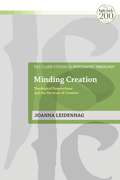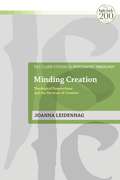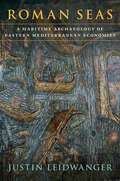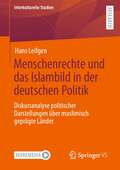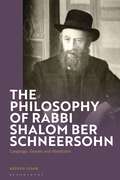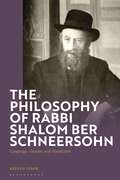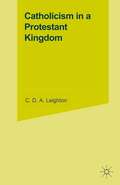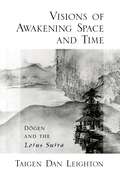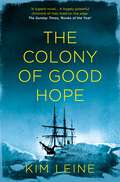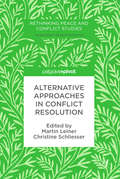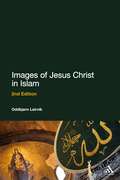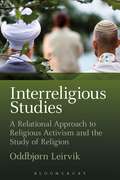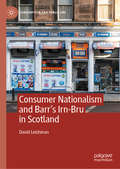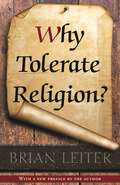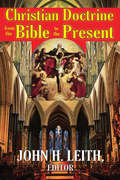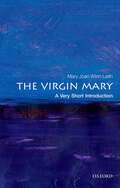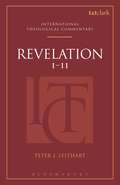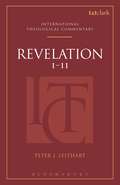- Table View
- List View
Minding Creation: Theological Panpsychism And The Doctrine Of Creation (T&T Clark Studies in Systematic Theology)
by Joanna LeidenhagAre humans the only creatures that can appreciate God's creation? What if consciousness is spread more widely across all things? This volume examines panpsychism through the lens of Christian doctrine. Minding Creation is the first substantial examination of what a panpsychist theory of consciousness implies for key theological debates concerning God's presence and action, evolution and the origin of the soul, human uniqueness and the environmental crisis.Joanna Leidenhag develops a theological panpsychism that is based on an exceptionally wide range of scholarship. Minding Creation draws on the theologies of historical figures such as Augustine of Hippo, Gottfried von Leibniz and others, in order to create a critical and constructive conversation with contemporary analytic philosophers of mind, such as Thomas Nagel, Galen Strawson, and David J. Chalmers. Leidenhag also discusses key concepts and issues, such as emergence theory, divine action, and ecology. She concludes that God created a universe from nothing which is filled with indwelling powers, sacramental value, and intrinsic experience. This is a creation in which the Holy Spirit is internally present at every point, a creation that worships God, and a creation that human beings must protect and lead in praise.
Minding Creation: Theological Panpsychism and the Doctrine of Creation (T&T Clark Studies in Systematic Theology)
by Joanna LeidenhagAre humans the only creatures that can appreciate God's creation? What if consciousness is spread more widely across all things? This volume examines panpsychism through the lens of Christian doctrine. Minding Creation is the first substantial examination of what a panpsychist theory of consciousness implies for key theological debates concerning God's presence and action, evolution and the origin of the soul, human uniqueness and the environmental crisis.Joanna Leidenhag develops a theological panpsychism that is based on an exceptionally wide range of scholarship. Minding Creation draws on the theologies of historical figures such as Augustine of Hippo, Gottfried von Leibniz and others, in order to create a critical and constructive conversation with contemporary analytic philosophers of mind, such as Thomas Nagel, Galen Strawson, and David J. Chalmers. Leidenhag also discusses key concepts and issues, such as emergence theory, divine action, and ecology. She concludes that God created a universe from nothing which is filled with indwelling powers, sacramental value, and intrinsic experience. This is a creation in which the Holy Spirit is internally present at every point, a creation that worships God, and a creation that human beings must protect and lead in praise.
Roman Seas: A Maritime Archaeology of Eastern Mediterranean Economies
by Justin LeidwangerThat seafaring was fundamental to Roman prosperity in the eastern Mediterranean is beyond doubt, but a tendency by scholars to focus on the grandest long-distance movements between major cities has obscured the finer and varied contours of maritime interaction. This book offers a nuanced archaeological analysis of maritime economy and connectivity in the Roman east. Drawing together maritime landscape studies and network analysis, Roman Seas takes a bottom-up view of the diverse socioeconomic conditions and seafaring logistics that generated multiple structures and scales of interaction. The material record of shipwrecks and ports along a vital corridor from the southeast Aegean across the northeast Mediterranean provides a case study of regional exchange and communication based on routine sails between simple coastal harbors. Rather than a single well-integrated and persistent Mediterranean network, multiple discrete and evolving regional and interregional systems emerge. This analysis sheds light on the cadence of economic life along the coast, the development of market institutions, and the regional continuities that underpinned integration-despite imperial fragmentation-between the second century BCE and the seventh century CE. Roman Seas advances a new approach to the synthesis of shipwreck and other maritime archaeological and historical economic data, as well as a path through the stark dichotomies-either big commercial voyages or small-scale cabotage-that inform most paradigms of Roman connectivity and trade. The result is a unique perspective on ancient Mediterranean trade, seafaring, cultural interaction, and coastal life.
Roman Seas: A Maritime Archaeology of Eastern Mediterranean Economies
by Justin LeidwangerThat seafaring was fundamental to Roman prosperity in the eastern Mediterranean is beyond doubt, but a tendency by scholars to focus on the grandest long-distance movements between major cities has obscured the finer and varied contours of maritime interaction. This book offers a nuanced archaeological analysis of maritime economy and connectivity in the Roman east. Drawing together maritime landscape studies and network analysis, Roman Seas takes a bottom-up view of the diverse socioeconomic conditions and seafaring logistics that generated multiple structures and scales of interaction. The material record of shipwrecks and ports along a vital corridor from the southeast Aegean across the northeast Mediterranean provides a case study of regional exchange and communication based on routine sails between simple coastal harbors. Rather than a single well-integrated and persistent Mediterranean network, multiple discrete and evolving regional and interregional systems emerge. This analysis sheds light on the cadence of economic life along the coast, the development of market institutions, and the regional continuities that underpinned integration-despite imperial fragmentation-between the second century BCE and the seventh century CE. Roman Seas advances a new approach to the synthesis of shipwreck and other maritime archaeological and historical economic data, as well as a path through the stark dichotomies-either big commercial voyages or small-scale cabotage-that inform most paradigms of Roman connectivity and trade. The result is a unique perspective on ancient Mediterranean trade, seafaring, cultural interaction, and coastal life.
Menschenrechte und das Islambild in der deutschen Politik: Diskursanalyse politischer Darstellungen über muslimisch geprägte Länder (Interkulturelle Studien)
by Hans LeifgenPolitische Berichte und menschenrechtliche Debatten prägen das Islambild in Deutschland mit. Die vorliegende Forschungsarbeit setzt sich exemplarisch mit der Menschenrechtsberichterstattung der politischen Fraktionen im Deutschen Bundestag über muslimisch geprägte Länder auseinander. Im Zentrum des Interesses stehen dabei die Fragen, wie die Menschenrechtslage in muslimisch geprägten Ländern dargestellt und welcher menschenrechtliche Bezugsrahmen verwendet wird sowie, welche Rolle die Religion Islam bei der Berichterstattung spielt. Hierzu werden die diskurstheoretische Perspektive Foucaults (1981) und der forschungsmethodische Zugang der Kritischen Diskursanalyse Jägers (2015) herangezogen. Ziel der Forschung ist, exemplarische Erkenntnisse über potenzielle gesamtgesellschaftliche Auswirkungen der Berichterstattung – insbesondere auf das Islambild in Deutschland – zu erhalten. Daher untersucht die Arbeit, wie bei der Berichterstattung Wirklichkeit konstruiert wird.
The Philosophy of Rabbi Shalom Ber Schneersohn: Language, Gender and Mysticism
by Rabbi Dr Reuven LeighReuven Leigh provides the first in-depth introduction to the pioneering philosophy of Rabbi Shalom Ber Schneersohn. Bringing him into dialogue with key continental philosophers Emmanuel Levinas, Jacques Derrida and Julia Kristeva, this book reveals how Schneersohn's views anticipated many prominent themes in 20th-century thought. Shalom Ber Schneersohn (1860-1920) was the fifth Rebbe of the Habad-Lubavitch dynasty. He was a traditional, kabbalistic thinker and yet, beyond mysticism, he wrote extensively on speech, gender and the body. So why is he not better known? Leigh begins by uncovering and contesting numerous scholarly assumptions that have operated to exclude traditional rabbinic thinkers from contemporary philosophical debates. Seeking to correct this, this book offers a close reading of Schneersohn's 1898 discourses. With the disruption of traditional binary structures being the dominant theme pervading Schneersohn's work, Leigh engages with Levinas' provocative ideas on speech and the feminine. He also highlights how Derridean deconstruction involves a more positive approach to presence that was already anticipated in the writings of Schneersohn. And from the disruption of the hierarchy of signification to the semiotic aspect of language and the maternal body, this book demonstrates how Schneersohn foreshadows a number of Kristeva's central philosophical concerns. A wide-ranging and inclusive volume, The Philosophy of Rabbi Shalom Ber Schneersohn demonstrates not only how forward-thinking Schneersohn's ideas were over a century ago, but how relevant they still are today.
The Philosophy of Rabbi Shalom Ber Schneersohn: Language, Gender and Mysticism
by Rabbi Dr Reuven LeighReuven Leigh provides the first in-depth introduction to the pioneering philosophy of Rabbi Shalom Ber Schneersohn. Bringing him into dialogue with key continental philosophers Emmanuel Levinas, Jacques Derrida and Julia Kristeva, this book reveals how Schneersohn's views anticipated many prominent themes in 20th-century thought. Shalom Ber Schneersohn (1860-1920) was the fifth Rebbe of the Habad-Lubavitch dynasty. He was a traditional, kabbalistic thinker and yet, beyond mysticism, he wrote extensively on speech, gender and the body. So why is he not better known? Leigh begins by uncovering and contesting numerous scholarly assumptions that have operated to exclude traditional rabbinic thinkers from contemporary philosophical debates. Seeking to correct this, this book offers a close reading of Schneersohn's 1898 discourses. With the disruption of traditional binary structures being the dominant theme pervading Schneersohn's work, Leigh engages with Levinas' provocative ideas on speech and the feminine. He also highlights how Derridean deconstruction involves a more positive approach to presence that was already anticipated in the writings of Schneersohn. And from the disruption of the hierarchy of signification to the semiotic aspect of language and the maternal body, this book demonstrates how Schneersohn foreshadows a number of Kristeva's central philosophical concerns. A wide-ranging and inclusive volume, The Philosophy of Rabbi Shalom Ber Schneersohn demonstrates not only how forward-thinking Schneersohn's ideas were over a century ago, but how relevant they still are today.
Catholicism in a Protestant Kingdom: A Study of the Irish Ancien Régime (Studies in Modern History)
by C.D.A. LeightonEscaping from narrative history, this book takes a deep look at the Catholic question in eighteenth-century Ireland. It asks how people thought about Catholicism, Protestantism and their society, in order to reassess the content and importance of the religious conflict. In doing this, Dr Cadoc Leighton provides a study of very wide appeal, which offers new and thought-provoking ways of looking not only at the eighteenth century but at modern Irish history in general. It also places Ireland clearly within the mainstream of European historical developments.
Visions of Awakening Space and Time: Dōgen and the Lotus Sutra
by Taigen Dan LeightonAs a religion concerned with universal liberation, Zen grew out of a Buddhist worldview very different from the currently prevalent scientific materialism. Indeed, says Taigen Dan Leighton, Zen cannot be fully understood outside of a worldview that sees reality itself as a vital, dynamic agent of awareness and healing. In this book, Leighton explicates that worldview through the writings of the Zen master Eihei Dōgen (1200-1253), considered the founder of the Japanese Sōtō Zen tradition, which currently enjoys increasing popularity in the West. The Lotus Sutra, arguably the most important Buddhist scripture in East Asia, contains a famous story about bodhisattvas (enlightening beings) who emerge from under the earth to preserve and expound the Lotus teaching in the distant future. The story reveals that the Buddha only appears to pass away, but actually has been practicing, and will continue to do so, over an inconceivably long life span. Leighton traces commentaries on the Lotus Sutra from a range of key East Asian Buddhist thinkers, including Daosheng, Zhiyi, Zhanran, Saigyo, Myōe, Nichiren, Hakuin, and Ryōkan. But his main focus is Eihei Dōgen, the 13th century Japanese Sōtō Zen founder who imported Zen from China, and whose profuse, provocative, and poetic writings are important to the modern expansion of Buddhism to the West. Dōgen's use of this sutra expresses the critical role of Mahayana vision and imagination as the context of Zen teaching, and his interpretations of this story furthermore reveal his dynamic worldview of the earth, space, and time themselves as vital agents of spiritual awakening. Leighton argues that Dōgen uses the images and metaphors in this story to express his own religious worldview, in which earth, space, and time are lively agents in the bodhisattva project. Broader awareness of Dōgen's worldview and its implications, says Leighton, can illuminate the possibilities for contemporary approaches to primary Mahayana concepts and practices.
Visions of Awakening Space and Time: Dōgen and the Lotus Sutra
by Taigen Dan LeightonAs a religion concerned with universal liberation, Zen grew out of a Buddhist worldview very different from the currently prevalent scientific materialism. Indeed, says Taigen Dan Leighton, Zen cannot be fully understood outside of a worldview that sees reality itself as a vital, dynamic agent of awareness and healing. In this book, Leighton explicates that worldview through the writings of the Zen master Eihei Dōgen (1200-1253), considered the founder of the Japanese Sōtō Zen tradition, which currently enjoys increasing popularity in the West. The Lotus Sutra, arguably the most important Buddhist scripture in East Asia, contains a famous story about bodhisattvas (enlightening beings) who emerge from under the earth to preserve and expound the Lotus teaching in the distant future. The story reveals that the Buddha only appears to pass away, but actually has been practicing, and will continue to do so, over an inconceivably long life span. Leighton traces commentaries on the Lotus Sutra from a range of key East Asian Buddhist thinkers, including Daosheng, Zhiyi, Zhanran, Saigyo, Myōe, Nichiren, Hakuin, and Ryōkan. But his main focus is Eihei Dōgen, the 13th century Japanese Sōtō Zen founder who imported Zen from China, and whose profuse, provocative, and poetic writings are important to the modern expansion of Buddhism to the West. Dōgen's use of this sutra expresses the critical role of Mahayana vision and imagination as the context of Zen teaching, and his interpretations of this story furthermore reveal his dynamic worldview of the earth, space, and time themselves as vital agents of spiritual awakening. Leighton argues that Dōgen uses the images and metaphors in this story to express his own religious worldview, in which earth, space, and time are lively agents in the bodhisattva project. Broader awareness of Dōgen's worldview and its implications, says Leighton, can illuminate the possibilities for contemporary approaches to primary Mahayana concepts and practices.
The Colony of Good Hope
by Kim LeineIn the tradition of Conrad’s Heart of Darkness, an immensely powerful historical novel about the first encounters between Danish colonists and Greenlanders in the early eighteenth century, of brutal clashes between priests and pagans and the forces that drive each individual towards darkness or light.1728: The Danish King Fredrik IV sends a governor to Greenland to establish a colony, in the hopes of exploiting the country’s allegedly vast natural resources. A few merchants, a barber-surgeon, two trainee priests, a blacksmith, some carpenters and soldiers and a dozen hastily married couples go with him.The missionary priest Hans Egede has already been in Greenland for several years when the new colonists arrive. He has established a mission there, but the converts are few. Among those most hostile to Egede is the shaman Aappaluttoq, whose own son was taken by the priest and raised in the Christian faith as his own. Thus the great rift between two men, and two ways of life, is born.The newly arrived couples – men and women plucked from prison – quickly sink into a life of almost complete dissolution, and soon unsanitary conditions, illness and death bring the colony to its knees. Through the starvation and the epidemics that beset the colony, Egede remains steadfast in his determination – willing to sacrifice even those he loves for the sake of his mission.In The Colony of Good Hope, Kim Leine explores what happens when two cultures confront one another. In a distant colony, under the harshest conditions, the overwhelming forces of nature meet the vices of man.
Alternative Approaches in Conflict Resolution (PDF)
by Martin Leiner Christine SchliesserThis edited volume brings together alternative and innovative approaches in conflict resolution. With traditional military intervention repeatedly leading to the transformation of entire regions into zones of instability and violence (Afghanistan, Iraq, Libya, Syria), the study of alternative and less violent approaches to conflict resolution has become imperative. Four approaches are presented here: negotiation, religion and gender, reconciliation and forgiveness, and the arts. This volume contains the insights and experiences of fourteen internationally renowned scholars and practitioners from different contexts. Can forgiveness help heal relationships in post-apartheid South Africa? How can art assist dealing with ‘unrememberable’ events such as the genocide in Rwanda? What transformational resources do women offer in contexts of massive human rights violations? The aim here is twofold: to provide and encourage critical reflection of the approaches presented here and to explore concrete improvements in conflict resolution strategies. In its interdisciplinary and international outlook, this work combines the tried-and-tested approaches from conflict resolution experts in academia, NGOs and civil society, making it an invaluable tool for academics and practitioners alike.
Images of Jesus Christ in Islam: 2nd Edition
by Oddbjørn LeirvikImages of Jesus Christ in Islam 2nd Edition provides a general introduction to the question of Jesus Christ in Islam and a dialogical discussion of this issues' importance for Christian-Muslim relations. Its originality lies in its comprehensive presentation of relevant sources and research and its discussion of Islamic images of Christ in the wider context of Muslim-Christian relations. Oddbjørn Leirvik provides a comprehensive introduction to a breadth of Muslim traditions through an examination of interpretations of Jesus throughout history, whilst also examining historic tensions between Islam and Christianity. This book's distinctive contribution lies in its dialogical perspective in the perennial area of interest of Islam and Christian-Muslim relations.
Images of Jesus Christ in Islam: 2nd Edition
by Oddbjørn LeirvikImages of Jesus Christ in Islam 2nd Edition provides a general introduction to the question of Jesus Christ in Islam and a dialogical discussion of this issues' importance for Christian-Muslim relations. Its originality lies in its comprehensive presentation of relevant sources and research and its discussion of Islamic images of Christ in the wider context of Muslim-Christian relations. Oddbjørn Leirvik provides a comprehensive introduction to a breadth of Muslim traditions through an examination of interpretations of Jesus throughout history, whilst also examining historic tensions between Islam and Christianity. This book's distinctive contribution lies in its dialogical perspective in the perennial area of interest of Islam and Christian-Muslim relations.
Interreligious Studies: A Relational Approach to Religious Activism and the Study of Religion
by Oddbjørn LeirvikThe notion of Interreligious Studies signals a new academic perspective on the study of religion, characterized by a relational approach. Interreligious Studies defines the essential features of interreligious studies compared with alternative conceptions of religious studies and theology. The book discusses pressing and salient challenges in interreligious relations, including interreligious dialogue in practice and theory, interfaith dialogue and secularity, confrontational identity politics, faith-based diplomacy, the question of interfaith learning in school, and interreligious responses to extremism. Interreligious Studies is a cutting-edge study from one of the most important voices in Europe in the field, Oddbjørn Leirvik, and includes case study material from his native Norway including interreligious responses to the bomb attack in Norway on 22nd July 2011, as well as examples from a number of other national and global contexts Expanding discussions on interreligious dialogue and the relationship between religions in new and interesting ways, this book is a much-needed addition to the growing literature on interreligious studies.
Interreligious Studies: A Relational Approach to Religious Activism and the Study of Religion
by Oddbjørn LeirvikThe notion of Interreligious Studies signals a new academic perspective on the study of religion, characterized by a relational approach. Interreligious Studies defines the essential features of interreligious studies compared with alternative conceptions of religious studies and theology. The book discusses pressing and salient challenges in interreligious relations, including interreligious dialogue in practice and theory, interfaith dialogue and secularity, confrontational identity politics, faith-based diplomacy, the question of interfaith learning in school, and interreligious responses to extremism. Interreligious Studies is a cutting-edge study from one of the most important voices in Europe in the field, Oddbjørn Leirvik, and includes case study material from his native Norway including interreligious responses to the bomb attack in Norway on 22nd July 2011, as well as examples from a number of other national and global contexts Expanding discussions on interreligious dialogue and the relationship between religions in new and interesting ways, this book is a much-needed addition to the growing literature on interreligious studies.
Consumer Nationalism and Barr’s Irn-Bru in Scotland: Iron Nation (Consumption and Public Life)
by David LeishmanThis book connects a detailed analysis of Irn-Bru’s brand identity over time to theories of national identity, consumer studies, and banal nationalism. It situates the commercial history of Barr’s Irn-Bru in a transnational context and shows how Irn-Bru has become a symbol of Scotland through processes of rewriting, reframing and institutionalized forgetting, linking the consumption of what began as a trans-national generic product to a specific national community. As such, Leishman presents a longitudinal, cross-disciplinary approach to analysing branding and advertising as multi-modal forms of discourse, in order to underline the role of commercial, non-state actors and popular consumerism in the phenomenon of banal nationalism. It will be of interest to students and scholars researching nationalism, consumption, and Scottish studies.
Why Tolerate Religion?
by Brian LeiterThis provocative book addresses one of the most enduring puzzles in political philosophy and constitutional theory—why is religion singled out for preferential treatment in both law and public discourse? Why are religious obligations that conflict with the law accorded special toleration while other obligations of conscience are not? In Why Tolerate Religion?, Brian Leiter shows why our reasons for tolerating religion are not specific to religion but apply to all claims of conscience, and why a government committed to liberty of conscience is not required by the principle of toleration to grant exemptions to laws that promote the general welfare.
Why Tolerate Religion?
by Brian LeiterThis provocative book addresses one of the most enduring puzzles in political philosophy and constitutional theory—why is religion singled out for preferential treatment in both law and public discourse? Why are religious obligations that conflict with the law accorded special toleration while other obligations of conscience are not? In Why Tolerate Religion?, Brian Leiter shows why our reasons for tolerating religion are not specific to religion but apply to all claims of conscience, and why a government committed to liberty of conscience is not required by the principle of toleration to grant exemptions to laws that promote the general welfare.
Christian Doctrine from the Bible to the Present
by John H. LeithChristianity has always been a "creedal" religion in that it has always been theological. It was rooted in the theological tradition of ancient Israel, which was unifi ed by its historical credos and declaratory affi rmations of faith. No pre-theological era has been discovered in the New Testament or in the history of the Christian community. From the beginning Christianity has been theological, involving men in theological refl ection and calling them to declarations of faith. A non-theological Christianity has simply never endured, although such has been attempted, for instance, by individual seers in the sixteenth century and also by collaborators with totalitarian ideologies in the twentieth century.The creeds presented here range from the ancient faith of the Hebrews and the creed-like formulas of the New Testament to the Barmen declaration of 1934 (framed by the Christians in Germany who faced the threat of Nazism) and the Batak Creed of 1951 (in which Indonesian Christians gave authentic expression to their religious belief in the idiom of their own culture. All the creeds are in some sense "offi cial," and every major division of Christendom is represented, including the Younger Churches. The volume ends with the messages of the most important assemblies dealing with the Ecumenical Movement.This single volume, containing all the major theological affi rmations of the Christian community, is a source book for the study of Christian theology. It comprises a record of the Church's interpretation of the Bible in the past and an authoritative guide to its interpretation on the present. Indeed, it is a guide to an understanding of the Christian interpretation of life.
Christian Doctrine from the Bible to the Present: A Reader In Christian Doctrine From The Bible To The Present
by John H. LeithChristianity has always been a "creedal" religion in that it has always been theological. It was rooted in the theological tradition of ancient Israel, which was unifi ed by its historical credos and declaratory affi rmations of faith. No pre-theological era has been discovered in the New Testament or in the history of the Christian community. From the beginning Christianity has been theological, involving men in theological refl ection and calling them to declarations of faith. A non-theological Christianity has simply never endured, although such has been attempted, for instance, by individual seers in the sixteenth century and also by collaborators with totalitarian ideologies in the twentieth century.The creeds presented here range from the ancient faith of the Hebrews and the creed-like formulas of the New Testament to the Barmen declaration of 1934 (framed by the Christians in Germany who faced the threat of Nazism) and the Batak Creed of 1951 (in which Indonesian Christians gave authentic expression to their religious belief in the idiom of their own culture. All the creeds are in some sense "offi cial," and every major division of Christendom is represented, including the Younger Churches. The volume ends with the messages of the most important assemblies dealing with the Ecumenical Movement.This single volume, containing all the major theological affi rmations of the Christian community, is a source book for the study of Christian theology. It comprises a record of the Church's interpretation of the Bible in the past and an authoritative guide to its interpretation on the present. Indeed, it is a guide to an understanding of the Christian interpretation of life.
The Virgin Mary: A Very Short Introduction (Very Short Introductions)
by Mary Joan LeithThe Virgin Mary - a Jewish mother - is central to Christianity, a revered woman in Islam, and a person of persistent fascination for centuries. Marian worship and theology has inspired countless appearances in art, as well as religious philosophy and doctrine, while the concept of the Virgin herself has been involved in controversial discussions over the Virginal body, race, anti-Semitism, and globalism. This Very Short Introduction describes the evolution of Marian thought from early Christianity to the present day. Mary Joan Winn Leith focuses on the centuries between the rise of Christianity and the Counter-Reformation, the eras when most of the doctrinal issues, popular traditions, and associated conventions of Marian iconography developed, and covers Catholic, Orthodox, and other Christian denominations, as well as the Islamic Mary. Taking an interdisciplinary approach that includes art history, archaeology, and gender studies as well as doctrinal history, she considers some of the misunderstandings and unquestioned assumptions about the Virgin Mary that pervade past and present Christian consciousness and today's secular world. Leith also discusses apparitions of Mary and representations of Mary in contemporary popular culture. Very Short Introductions: Brilliant, Sharp, Inspiring ABOUT THE SERIES: The Very Short Introductions series from Oxford University Press contains hundreds of titles in almost every subject area. These pocket-sized books are the perfect way to get ahead in a new subject quickly. Our expert authors combine facts, analysis, perspective, new ideas, and enthusiasm to make interesting and challenging topics highly readable.
The Virgin Mary: A Very Short Introduction (Very Short Introductions)
by Mary Joan LeithThe Virgin Mary - a Jewish mother - is central to Christianity, a revered woman in Islam, and a person of persistent fascination for centuries. Marian worship and theology has inspired countless appearances in art, as well as religious philosophy and doctrine, while the concept of the Virgin herself has been involved in controversial discussions over the Virginal body, race, anti-Semitism, and globalism. This Very Short Introduction describes the evolution of Marian thought from early Christianity to the present day. Mary Joan Winn Leith focuses on the centuries between the rise of Christianity and the Counter-Reformation, the eras when most of the doctrinal issues, popular traditions, and associated conventions of Marian iconography developed, and covers Catholic, Orthodox, and other Christian denominations, as well as the Islamic Mary. Taking an interdisciplinary approach that includes art history, archaeology, and gender studies as well as doctrinal history, she considers some of the misunderstandings and unquestioned assumptions about the Virgin Mary that pervade past and present Christian consciousness and today's secular world. Leith also discusses apparitions of Mary and representations of Mary in contemporary popular culture. Very Short Introductions: Brilliant, Sharp, Inspiring ABOUT THE SERIES: The Very Short Introductions series from Oxford University Press contains hundreds of titles in almost every subject area. These pocket-sized books are the perfect way to get ahead in a new subject quickly. Our expert authors combine facts, analysis, perspective, new ideas, and enthusiasm to make interesting and challenging topics highly readable.
Revelation 1-11 (T&T Clark International Theological Commentary)
by Peter J. LeithartThe Book of Revelation is the last book in the canon of the New Testament, and its only apocalyptic document, though there are short apocalyptic passages in various places in the gospels and the epistles. This first of two volumes on Revelation offers systematic and thorough interpretation of the book of Revelation. Revelation brings together the worlds of heaven, earth and hell in a final confrontation between the forces of good and evil. Its characters and images are both real and symbolic, spiritual and material, and it is frequently difficult to know the difference between them. Revelation's cryptic nature has ensured that it would always be a source of controversy. This commentary focuses on the theological content, gleaning the best from both the classical and modern commentary traditions and showing the doctrinal development of Scriptural truths. Scholarship on the book of Revelation has nonetheless not only endured, but even captured the imagination of generations of Bible students, both professionals and laypeople alike. Through its focus on the message of the book through scholarly analysis, this International Theological Commentary reconnects to the ecclesial tradition of biblical commentary as an effort in ressourcement, though not slavish repetition.
Revelation 1-11 (T&T Clark International Theological Commentary)
by Peter J. LeithartThe Book of Revelation is the last book in the canon of the New Testament, and its only apocalyptic document, though there are short apocalyptic passages in various places in the gospels and the epistles. This first of two volumes on Revelation offers systematic and thorough interpretation of the book of Revelation. Revelation brings together the worlds of heaven, earth and hell in a final confrontation between the forces of good and evil. Its characters and images are both real and symbolic, spiritual and material, and it is frequently difficult to know the difference between them. Revelation's cryptic nature has ensured that it would always be a source of controversy. This commentary focuses on the theological content, gleaning the best from both the classical and modern commentary traditions and showing the doctrinal development of Scriptural truths. Scholarship on the book of Revelation has nonetheless not only endured, but even captured the imagination of generations of Bible students, both professionals and laypeople alike. Through its focus on the message of the book through scholarly analysis, this International Theological Commentary reconnects to the ecclesial tradition of biblical commentary as an effort in ressourcement, though not slavish repetition.
